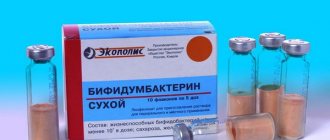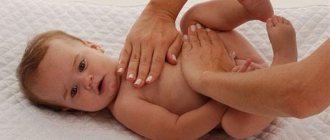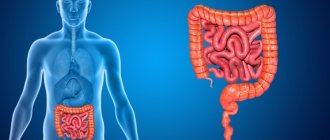Causes
Necrotizing enterocolitis is epidemic in most neonatal intensive care units. Outbreaks of the disease are associated with a number of microorganisms - Klebsiella pneumoniae, Escherichia coli, Clostridia, coagulase-negative staphylococcus, rotavirus. Since there is no single universal cause for the development of enterocolitis, it is customary to identify a number of risk factors that predispose to the disease, namely: intestinal ischemia, immaturity of defense mechanisms, enteral feeding.
The role of ischemia in the pathogenesis of necrotizing enterocolitis in newborns is confirmed by data on its frequent association with factors such as low Apgar scores, catheterization of umbilical vessels, polycythemia, and reduced blood flow in the systemic circulation. It is generally accepted that in conditions of hypoxia or hypotension, a redistribution of blood flow occurs with centralization of the blood circulation and hypoperfusion of the abdominal organs. Despite the absence of a direct cause-and-effect relationship between hypoxia and necrotizing enterocolitis, there are differences in the regulation of vascular tone and blood flow in premature and mature children. The intestines of premature babies are more sensitive to the damaging effects of hypoxia and oxygen free radicals, which have a negative effect on tissues during the period of their reperfusion. With catheterization of the umbilical vessels and increased pressure in the portal system, a decrease in blood flow in the ileum or colon may occur. Catheter embolism can lead to mesenteric arterial embolism. The introduction of calcium preparations into the vessels of the umbilical cord can cause vasospasm. Necrotizing enterocolitis has also been described in children receiving indomethacin for closure of the ductus arteriosus.
Local defense mechanisms in premature newborns are absent or functionally immature, which facilitates colonization of the intestine by pathogenic microflora. In the pathogenesis of necrotizing enterocolitis, the role of inflammatory mediators, in particular platelet-activating factor, is considered. This factor is synthesized by leukocytes and stimulates the release of complement, oxygen radicals, catecholamines, prostaglandins, thromboxane, and leukotrienes. Plasma concentrations of this factor are higher in children who have had enterocolitis compared to healthy newborns. Moreover, enteral nutrition contributes to an increase in factor concentration. In turn, the protective factors of breast milk (immunoglobulins, antibacterial agents) can have a protective effect against the development of the disease.
Necrotizing enterocolitis of the newborn
Oh, all-holy Nicholas, exceedingly saintly servant of the Lord, our warm intercessor, and everywhere in sorrow a quick helper! Help me, sinful and sad, in this present life, beg the Lord God to grant me forgiveness of all my sins, which I have sinned greatly from my youth, in all my life, in deed, word, thought and all my feelings; and at the end of my soul, help me the accursed, beg the Lord God, the Creator of all creation, to deliver me from airy ordeals and eternal torment: may I always glorify the Father and the Son and the Holy Spirit, and your merciful intercession, now and ever, and forever and ever. Amen.
Prayer for the health of children
O Most Holy Lady Virgin Theotokos, save and preserve under Your shelter my children (names), all youths, young women and infants, baptized and nameless, and carried in their mother’s womb. Cover them with the robe of Your motherhood, keep them in the fear of God and obedience to their parents, pray to my Lord and Your Son to grant them what is useful for their salvation. I entrust them to Your maternal supervision, for You are the Divine protection of Your servants.
The Most Holy Theotokos in front of Her “Healer” icon
Troparion, tone 4:
Like the Most Bright Star, asking for Divine miracles Your holy image to the Healer. Grant us, Mother of God Mary, healing of mental and physical ailments, salvation and great mercy.
Prayer:
Accept, O All-Blessed and All-Powerful Lady Theotokos the Virgin, these prayers, now brought to You with tears from us, Your unworthy servants, to Your whole-bearing image the singing of those who send up with tenderness, as if You yourself are here and heed our prayer. For every request you fulfill, you alleviate sorrows, you grant health to the weak, you heal the weakened and sick, you drive away demons from demons, you deliver the offended from insults, you cleanse lepers and you are kind to little children; Moreover, O Lady, Lady Theotokos, you free us from bonds and prisons and heal all manifold passions: for all things are possible through Your intercession to Your Son, Christ our God. Oh , All-Singing Mother, Most Holy Theotokos! Do not cease to pray for us, Your unworthy servants, who glorify You and honor You, and who worship Your Most Pure Image with tenderness, and who have irrevocable hope and undoubted faith in You, the Ever-Virgin, Most Glorious and Immaculate, now and ever and unto the ages of ages. Amen.
Hang in there, get well soon son!!!!!!!!!!!!!!!!!!!!!!!!!!!!!!!!!!!
Modified on December 22, 2013 by dreamer
Symptoms and diagnosis
Clinical symptoms of necrotizing enterocolitis in newborns are quite variable. The most common signs include bloating (enlargement) of the abdomen, vomiting, the flow of bile through a nasogastric tube, increased frequency and dilution of stools, and the presence of unchanged blood in the stool. During auscultation, intestinal motility is not heard due to the development of dynamic intestinal obstruction (paresis). General symptoms include temperature instability, apnea, decreased spontaneous motor activity, and hypotension. Increased pressure in the abdominal cavity due to bloating can lead to respiratory problems. These symptoms develop acutely or gradually.
In diagnosing the disease, radiography of the abdominal cavity is primarily used.
Nonspecific signs found in necrotizing enterocolitis in newborns include dilation of intestinal loops, thickening of its walls, and the presence of effusion in the peritoneal cavity. The diagnostic symptom of the disease is the presence of intestinal pneumatosis. These changes are caused by the accumulation of hydrogen in the intestinal wall as a product of bacterial metabolism. A linear streak of gas within the wall may be observed, either isolated in the small intestine or extending into the large intestine. Another radiological symptom is the presence of gas bubbles in the intestinal lumen. If the disease is complicated by perforation, pneumoperitoneum (the presence of strips of free gas in the abdominal cavity) is determined by x-ray. With the development of peritonitis, darkening in the lower abdomen and upward displacement of the intestinal loops are determined.
Mechanism of disease development
Diseases that many premature newborns suffer cause ischemia of the intestinal mucosa, as a result of centralization of blood circulation, vasospasm, and sometimes microthrombosis of the vessels of the affected organ. Some conditions can already interfere with intestinal blood circulation during the prenatal period. This could be maternal drug addiction or placental insufficiency.
As a result of pathological reactions, local immunity decreases and against an unfavorable background, it is easier for microorganisms to infect the intestinal wall. The development of the disease is affected by the nature of the child’s diet. Breast milk has a beneficial effect on the gastrointestinal tract of the newborn and on the general condition of the child. Also, with natural feeding, there is no need to calculate the amount of food provided that the baby is breastfeeding. In premature babies there is a risk of intestinal overload, which also adversely affects the disease.
Treatment
The goal of treatment of necrotizing enterocolitis in newborns is primarily to limit the progression of the disease. If the child was fed enterally, such feeding is stopped and gastric decompression is performed. Broad-spectrum antibiotics are prescribed taking into account their effect on nosocomial flora. These drugs include 2-3rd generation cephalosporins (cefoxitin, ceftazidime), 3rd generation aminoglycosides (tobramycin, amikacin, netromycin), carbapenems (thienam, meronem), and antistaphylococcal antibiotics (vancomycin) can also be prescribed.
If signs of intestinal perforation appear, antianaerobic drugs (metronidazole, clindamycin) are included in treatment. Central venous access is provided and parenteral nutrition is administered. Since, as a result of the inflammatory process in the intestine, significant sequestration of fluid occurs in the third space, it is necessary to correct hypovolemia with colloid and crystalloid drugs (fresh frozen plasma, albumin, glucose-saline solutions) during the first 2 - 3 days, as well as maintain stable hemodynamics and peripheral perfusion by administering inotropes (dopamine). If respiratory disorders occur, children may be transferred to assisted or artificial ventilation.
X-ray monitoring can be carried out every 6-8 hours during the first 2-3 days of the disease. About 1/4-1/2 of patients require surgical intervention. The most important indication for surgery is the presence of pneumoperitoneum. Other indications may include: clinical deterioration despite aggressive therapy; the presence of gas in the portal vein system and constantly dilated intestinal loops on a series of radiographs; signs of peritonitis or intestinal gangrene. The purpose of the operation is to excise the necrotic intestine and revise the abdominal cavity.
If the course of the disease is favorable, enteral feeding can be resumed after 10-14 days.
NECROTIZING ENTEROCOLITIS IN NEWBORNS
Necrotizing enterocolitis (NEC) is a neonatal inflammatory bowel disease and is one of the most threatening disease in neonatal gastroenterology. The average incidence of necrotizing enterocolitis 2.4:1000 infants (1 to 10:1000), or about 2.1% (from 1 to 7%) of the total number of children entering the neonatal intensive care unit. The incidence of disease increases with decreasing gestational age at birth. The share of full-term infants accounts for 10-20% of cases of NEC. This paper summarizes the results of our own research and the literature dedicated to this problem.
NECROTIZING ENTEROCOLITIS OF NEWBORNS
Russian National Research Medical University named after N.I. Pirogov
Chubarova Antonina Igorevna E-mail:
Necrotizing enterocolitis (NEC) of newborns is an inflammatory bowel disease and is one of the most devastating diseases in neonatal gastroenterology. The average incidence of necrotizing enterocolitis is 2.4:1000 newborns (range 1 to 10:1000), or about 2.1% (range 1 to 7%) of the total number of children admitted to neonatal intensive care units. The incidence of the disease increases with decreasing gestational age of the child at birth. Term newborns account for 10-20% of NEC cases. The paper summarizes the results of our own research and literature data on this problem.
Key words: necrotizing enterocolitis; newborn; children.
Necrotizing enterocolitis (NEC) is a neonatal inflammatory bowel disease and is one of the most threatening disease in neonatal gastroenterology. The average incidence of necrotizing enterocolitis 2.4:1000 infants (1 to 10:1000), or about 2.1% (from 1 to 7%) of the total number of children entering the neonatal intensive care unit. The incidence of disease increases with decreasing gestational age at birth. The share of full-term infants accounts for 10-20% of cases of NEC. This paper summarizes the results of our own research and the literature dedicated to this problem. Keywords: necrotizing enterocolitis; newborn; children.
ETIOLOGY AND PATHOGENESIS
Necrotizing enterocolitis (NEC) of newborns is an inflammatory bowel disease and is one of the most dangerous diseases in neonatal gastroenterology. Average mortality rates for NEC range from 10 to 45% and depend, in addition to the degree of maturity, also on the stage and extent of the process. Children who have developed intestinal perforation and peritonitis have the highest mortality, especially when the inflammatory process spreads to the jejunum and more proximally: to the duodenum and stomach (up to 63%).
The average incidence of necrotizing enterocolitis is 2.4:1000 newborns (range 1 to 10:1000), or about 2.1%
(from 1 to 7%) of the total number of children admitted to neonatal intensive care units. The incidence of the disease increases with decreasing gestational age of the child at birth. Term newborns account for 10-20% of NEC cases.
NEC is considered as a polyetiological inflammatory bowel disease. Risk factors for the development of NEC include: 1) prematurity, 2) hypoxia/asphyxia, 3) bacterial colonization of the intestine with pathogenic microflora, 4) enteral nutrition.
Prematurity as such may be a favorable background for the development of the disease due to:
• higher frequency of intrauterine hypoxia and asphyxia during childbirth;
• features of the formation of intestinal biocenosis in intensive care conditions;
• features of the interaction of intestinal cells with immunocompetent cells in newborns and excessive activity of the inflammatory response,
• immaturity of the intestinal nervous system and mechanisms of regulation of intestinal motility;
• violation of the mechanisms of adaptation to enteral nutrition in premature infants due to immaturity and lack of early natural feeding;
• imperfection of local immunity. One of the leading links in the pathogenesis of NEC, according to
According to most authors, this is a violation of microcirculation in the intestine. Hypoxia, especially intrauterine, can significantly change the blood supply to the gastrointestinal tract. In children who have suffered intrauterine hypoxia, changes in blood flow in the mesenteric vascular system persist postnatally, and in this group of children symptoms of disadaptation of the gastrointestinal tract to enteral nutrition are much more common (86% compared to 24% in the control group). Hypoxia, as a powerful stress factor, activates the immune system, which is reflected in an increase in the synthesis of pro-inflammatory cytokines and other regulatory substances. However, ischemia of the intestinal wall is not the only pathogenetic factor in NEC. Clinical and pathomorphological changes in NEC indicate a synergistic effect of ischemia and bacterial aggression factors during the development of the disease.
Ischemia followed by reperfusion helps maintain the increased permeability of the intestinal wall, characteristic of premature infants. Increased permeability facilitates the translocation of bacteria into the intestinal wall and then into the systemic circulation. It is important that massive contamination of the intestinal cavity with bacteria can lead to translocation even in the absence of changes in permeability and disturbances in intercellular contacts, for example in a number of full-term children with NEC.
In children with NEC, in a high percentage of cases, microorganisms are inoculated that can have a damaging effect on the intestinal wall: E. coli, Klebsiella, Staphilococcus, Bacteroides fragilis, Clostridium perfringens, Clostridium deficile, Enterobacter. However, statistical analysis of risk factors for the occurrence of NEC does not allow us to identify any single microorganism, the contamination of which would be an independent risk factor for the occurrence of enterocolitis. A special role in the initiation of the inflammatory process in the intestinal wall in NEC belongs to lipopolysaccharide (LPS)
gram-negative bacteria. The LPS content in the stool of children with NEC is significantly higher than in children without NEC; There is also a difference in the severity of lipopolysaccharide excretion in stool at different stages of the disease. LPS, as a result of interaction with ThB.2 receptors on the enterocyte, activates the production of cyclooxygenase 2, which provides reactions for the synthesis of prostaglandins, thromboxanes and leukotrienes in the enterocyte. In NEC, a higher level (compared to the level with intestinal malformations) of interleukin 1P (1L-1P), a higher level of tumor necrosis factor a (TMB-a), 1b-8, I-11, H- 18, I-12. 84% of children with NEC have all the signs of not only a local, but also a systemic inflammatory reaction; with the development of intestinal perforations, the incidence of a systemic inflammatory reaction reaches 100%.
NEC develops in 70-80% of cases after the start of enteral nutrition, therefore it is accepted to classify the presence of enteral nutrition as a risk factor for the development of NEC. However, the disease can also occur on total parenteral nutrition (TPN). The practice of recent decades, as well as a number of scientific works, prove the important role of feeding practices in the development of NEC. More careful administration of enteral nutrition with strict monitoring of intake has reduced the incidence of the disease in many neonatal centers. Currently, there is no doubt about the need for strict clinical and laboratory monitoring of the absorption of enteral nutrition by premature infants.
Increasing the proportion of breast milk in the diet of very low birth weight infants reduces the incidence of NEC and sepsis compared with infants fed preterm formula. The incidence of NEC falls in direct proportion to the proportion of breast milk in the diet of preterm infants. The preventive role of natural feeding is probably its ability to reduce the pro-inflammatory response and provide mucosal repair.
NEC is histologically characterized by inflammation and extensive tissue damage to the intestinal wall. Specific histopathological changes in the initial stages are swelling and detachment of the villous epithelium, pronounced leukocyte infiltration, then signs of villous destruction, swelling of the submucosal membrane, the appearance of microhemorrhages, microthrombosis, and blood stasis in the capillaries appear. In severe cases, complete disappearance of the structure of the villi, ulceration of the mucous membrane may occur, gas bubbles are visualized (pneumatosis), in
Ü 3 Can't find what you need? Try the literature selection service.
Can't find what you need? Try the literature selection service.
In domestic practice, the clinical course of NEC is usually divided into 4 stages. The fundamental difference from Bell’s classification is the identification of the prodrome stage, when there are no reliable signs of NEC. Representatives of the national school of pediatric surgeons, in particular T.V., made a great contribution to the study of the problem of NEC. Krasovskaya. Isolating this stage reduces the risk of untimely diagnosis and allows timely changes in patient management tactics.
1. Prodrome stage.
• The volume of stagnant contents in the stomach increases.
• Green stool with mucus.
• Sometimes symptoms from the respiratory system appear first - the work of breathing increases, more stringent mechanical ventilation parameters are required, and attacks of apnea occur.
2. Stage of clinical manifestations. Sluggish sucking.
Frequent regurgitation, including with an admixture of bile.
Weight loss. Reduction of stool.
Blood in the stool (detected visually or by a reaction to occult blood). Sometimes the stool is loose and excicosis develops.
Tension, pain in the anterior abdominal wall.
Swelling, cyanosis of the anterior abdominal wall.
Peristalsis is sluggish or absent. There is no or scanty stool with scarlet blood. The anus is closed, the intestinal mucosa is slightly vulnerable.
4. Stage of perforation and peritonitis. Peritoneal shock.
Signs of air in the abdominal cavity.
Children with NEC should be considered at high risk for the development of sepsis. In 84% of children with NEC, signs of a systemic inflammatory response are detected. In 60% of children during the course of NEC, other purulent-inflammatory diseases are detected. At least 75% of children with NEC have multiple organ failure involving 2 or more systems; NEC is characterized by disturbances in acid-base balance - metabolic acidosis, hypo- and hyperglycemia, disseminated intravascular coagulation syndrome. The incidence of systemic inflammation and multiple organ failure increases with the progression of the disease.
The course of the disease is often cyclical, but relapses of the disease are possible, including after closure of intestinal stomas.
Diagnosis is based on an assessment of the above risk factors, clinical picture, and x-ray examination. Ultrasound examination of the abdominal cavity is also used, and in doubtful cases, laparocentesis.
Radiological signs of NEC.
1. Dilatation of intestinal loops (55-100% of cases).
2. Decreased gas filling and asymmetrical arrangement of intestinal loops
3. Pneumatosis of the intestinal wall (19-98%).
4. Gas in the portal system (61% with total damage).
5. Pneumoperitoneum (12-30%).
6. Fluid in the abdominal cavity (11%), indirect signs of the presence of which are:
• severe bloating in the absence of gas filling of the intestinal loops;
• gas-filled intestinal loops in the center
• separation of intestinal loops.
1. Persistent dilatation of intestinal loops.
2. The presence of a fixed (static) loop.
3. Toxic dilatation of the colon.
4. Gastric dilatation.
X-ray contrast examination with metrizamide is used to diagnose perforation of a hollow organ. During the convalescence stage and in preparation for surgical intervention to close a previously created intestinal stoma, X-ray contrast examination of the outlet section is used to assess intestinal patency.
ü 3 Can't find what you need? Try the literature selection service.
1. Tumor-like formation of the abdominal cavity.
2. Inflammatory changes in the abdominal wall. Induration, swelling or fibrous inflammation of the subcutaneous tissue of the abdominal wall are ominous signs that usually appear in the presence of an underlying abscess, peritonitis or gangrene of the intestine.
4. Laboratory data. Acute thrombocytopenia, coagulation disorders, severe hyponatremia and persistent acidosis confirm the presence of necrosis of the intestinal wall.
5. Abdominal paracentesis. The following data indicate necrosis of the intestinal wall: turbid brown liquid, detection of extracellular bacteria by Gram stain, a large number of leukocytes, predominance of neutrophils - more than 80%.
The resumption of EN in patients with NEC is carried out gradually. Prescription of EN is possible in the case of complete relief of pain, absence of signs of peritoneal irritation, regurgitation syndrome, hemorrhagic syndrome, restoration of peristalsis (usually no earlier than 3 days), relief of systemic inflammation and disseminated intravascular coagulation syndrome. After eliminating the listed clinical symptoms, enteral nutrition can be started. In a number of institutions, nutrition is preceded by the introduction of isosmolar fluid: saline or glucose-saline solution in a volume corresponding to trophic nutrition (about 0.5 ml/kg/hour) for 0.5-1 days. With satisfactory absorption of fluid: absence of stagnant contents in the stomach, regurgitation, increasing bloating, preservation of satisfactory peristalsis, presence of independent stool without blood, it is possible to prescribe products for enteral nutrition. The appearance of the listed symptoms of NEC at any stage of nutrition is an indication for its cancellation and resumption of total parenteral nutrition. As the first product for enteral nutrition, if the mother has milk, it is possible to prescribe native breast milk from her own mother in combination with lactase preparations. In the absence of native breast milk after a period of parenteral nutrition, it is preferable to feed with formulas based on high-grade protein hydrolyzate diluted with water 3:1 (25% mixture), then 1:1 (50% mixture), then in a standard concentration. After complete relief of the inflammatory process and transfer to full enteral nutrition with formulas based on protein hydrolyzate, formulas for premature infants are gradually introduced to premature infants, and standard adapted formulas or lactose-free formulas are gradually introduced to full-term infants, depending on the presence of secondary lactase deficiency. According to indications, pancreatic enzymes are prescribed and dysbiotic disorders are corrected. Feeding of children who have undergone surgery due to intestinal perforation or necrosis is carried out according to the appropriate
protocols for the management of children with post-resection syndrome.
Outcomes. In children who have undergone NEC, but have not required intestinal resection, intestinal motility disorders and secondary lactase deficiency may persist for 1-3 months after the disease, but by 3 months in most cases, digestive and absorption functions are normalized. In children who have undergone intestinal resection due to intestinal necrosis, perforation, peritonitis, the prognosis will be determined
the volume of resection (the most unfavorable options are those with extensive resection of the jejunum), the level of stoma (if the first surgical intervention was performed with the removal of the stoma), the condition of the intestinal section located distal to the perforation. Children with NEC are the largest group among children developing short bowel syndrome (intestinal failure due to loss of absorption surface).
| "Transport strategy XXI century" |
| "Medicine targeted projects" |
| "Transport strategy XXI century" |
| "Medicine targeted projects" |
Complications
Among half of the surviving children, long-term complications are possible - intestinal strictures and short bowel syndrome. Strictures form due to fibrosis and are most often located in the colon. In such children, 2-3 weeks after recovery, bloating develops again. Typically, the presence of strictures requires surgical excision. Due to resection of intestinal sections, children may experience malabsorption syndrome and short bowel syndrome.
The normal length of the small intestine in newborns is 2-3 m. The most common cause of the development of short bowel syndrome is resection of its sections with necrotizing enterocolitis, midgut volvulus, jejunal or ileal atresia, gastroschisis. Shortening the intestine results in a decrease in the surface area from which nutrients and electrolytes are absorbed. Resection of the ileocecal segment leads to more serious disorders, since due to the absence of the ileocecal valve, reflux from the large intestine into the small intestine with colonization by colonic microflora is possible. Adaptation of the intestine after resection consists of its moderate dilatation, hypertrophy of the mucous membrane, which increases the absorption area per unit length of the intestine. As the child grows, the length of the intestines also increases. An increase in size and increased functional activity of the mucous membrane is more typical for the ileum compared to the jejunum. The adaptation processes may not be fully completed even by 2 years. However, in the neonatal period it is extremely important to carry out proper management of such children in order to establish normal bowel function in the future.
With short bowel syndrome, steatorrhea, deficiency of vitamins and some microelements may develop, since the absorption of bile salts, fat-soluble vitamins and minerals occurs in the distal part of the ileum. To reduce steatorrhea, cholestyramine is used, an ion exchange resin that binds bile salts. Malabsorption of fats should be eliminated by additional enteral or parenteral administration. It is also necessary to carry out additional administration of vitamins A, D, E, K, B12, zinc and magnesium. After intestinal resection, an increase in the secretory activity of the stomach is possible. To prevent this condition, which can contribute to the formation of low pH in the duodenum and inactivation of pancreatic enzymes, H2 blockers (cimetidine) are used. With excessive colonization of the small intestine by large intestinal microflora, the absorption of fats and vitamin B12 may be impaired, and the levels of maltase, lactase, sucrase, and enterokinase may decrease, which leads to diarrhea due to malabsorption. In this situation, cyclic courses of antibacterial therapy are prescribed.
The information presented in this article is intended for informational purposes only and cannot replace professional advice and qualified medical care. If you have the slightest suspicion that you have this disease, be sure to consult your doctor!











